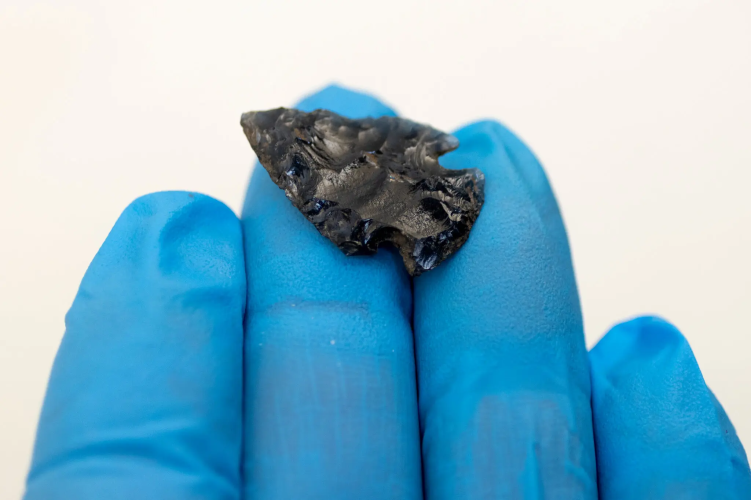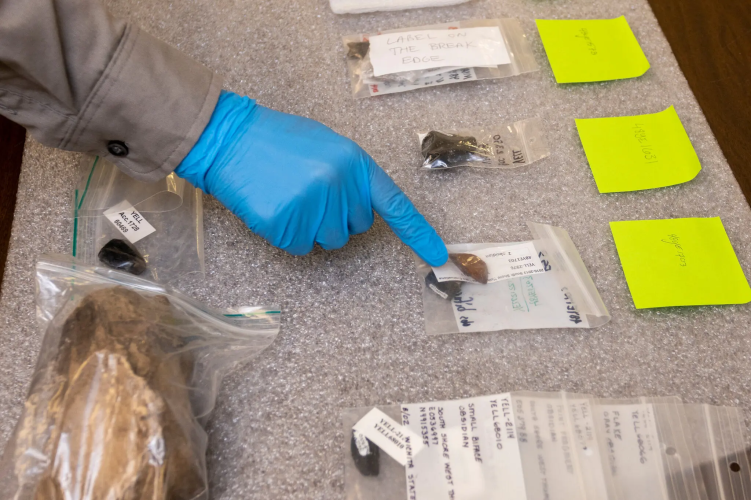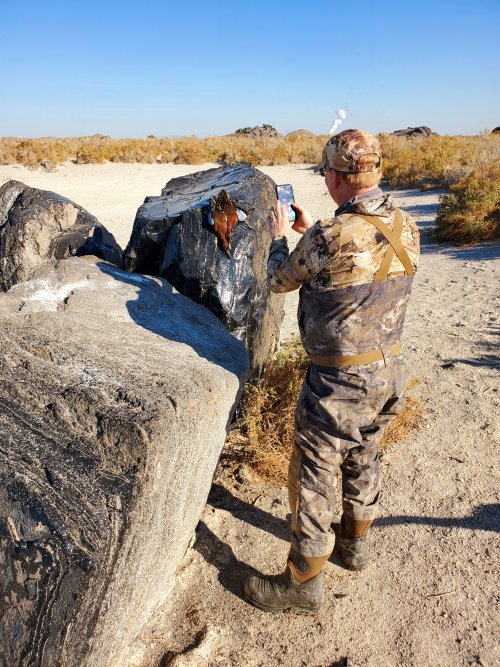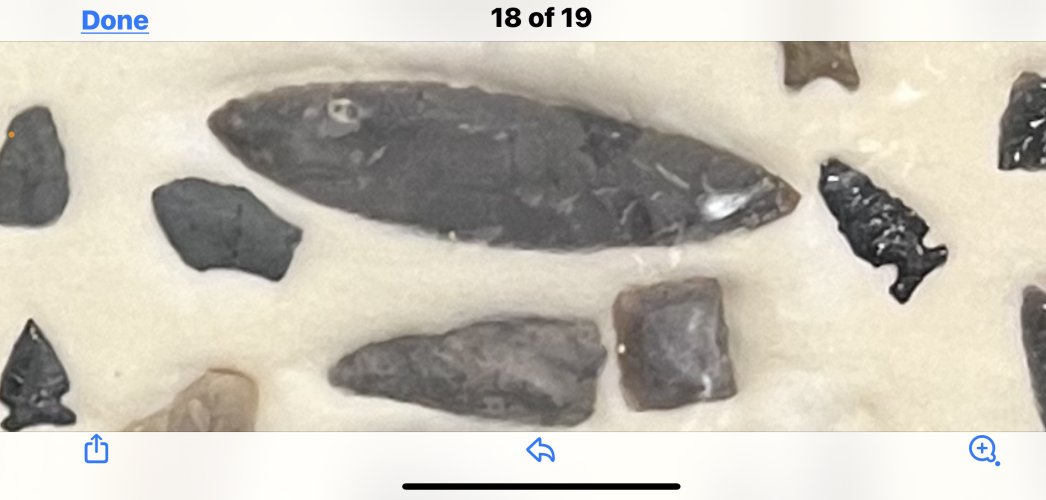I've picked up a lot of obsidian flakes and points all over SW Montana, including at over 10,000' in the mountains. This good article from today's NYT's sheds even more light on it...

 www.nytimes.com
www.nytimes.com
YELLOWSTONE NATIONAL PARK, Wyo. — Near the north entrance, an imposing mountain of black glass rises against the blue sky.
Spanning more than five square miles, the dark, sometimes translucent mass was formed from a rhyolitic lava flow that oozed out of the magma chamber of Yellowstone Caldera beneath the park, and cooled rapidly in the bitter cold of a glacial maximum, about 180,000 years ago.
Known as Obsidian Cliff, the Yellowstone mountain is one of the country’s highest quality deposits of “the sharpest natural substance on Earth,” according to Douglas H. MacDonald, a professor of anthropology at the University of Montana and the author of “Before Yellowstone: Native American Archaeology in the National Park.”
Obsidian is among the most prized tool stones in the world, and this particular deposit, nearly 100 feet thick, is exceptional because of its continual use by Indigenous people since the last ice age. Over the last 11,500 years or so, the stone has been fashioned into deadly knives, razor-sharp spear points, darts for atlatls, or spear-throwers, and arrowheads.
The cliff is “nationally significant because we had Native American groups from all over the country visiting it and collecting the stone and trading for it,” Dr. MacDonald said.
For modern day researchers, the obsidian columns of Yellowstone have helped to reveal the travels and migration of people thousands of years ago. X-ray fluorescence technology has been used to identify the unique geochemical fingerprint of each separate deposit of obsidian, pinpointing the provenance of artifacts found elsewhere. Obsidian from here has been found across the continent.
A fingerprint for the most prized tool stone in paleoindian cultures transformed the field. It provides a window into the past, a flow through both space and time over thousands and, in some places, millions of years. It opens up unknown and unimagined connections and deepens the understanding of migration, networking and trade in populations around the world.
“We can figure out where people are moving on the landscape and from there how the tools themselves reflect their strategies and culture,” said Elizabeth A. Horton, the archaeologist for Yellowstone, as she displayed obsidian knives and spear points from the park’s archives. “How did they interact with this landscape? Where did people go to visit? What was at that location?”
The application of X-ray technology to archaeology arose in the 1960s “and changed everything,” said M. Steven Shackley, director of the Geoarchaeological XRF laboratory in Albuquerque and author of “X-ray Fluorescence Spectrometry (XRF) in Geoarchaeology.” “Before that you had to infer. They either just guessed or didn’t do it.”
In recent decades, the technology has become easier to use, more portable and far less expensive.
The smooth, sensuous black glass has been an important part of hunter-gatherer cultures for about two million years, going back to Homo habilis, one of the first human ancestors who made crude stone tools. (A very modern reference would include the fictional land of Westeros, the setting for the HBO series “Game of Thrones,” where it was called dragon glass and made by “the fires of the earth.”)\
Researchers are using the approach to study both newly discovered artifacts and to re-examine existing collections. Archaeologists at Yale recently deployed the X-ray fluorescence technology on obsidian artifacts that were gathered at the university’s Peabody Museum in the 1960s from two key sites in southwestern Iran.
The tools, which date back nearly 10,000 years, were originally believed to have come from two sources on the Deh Luran Plain in Iran. But the analysis showed that the volcanic glass came from seven places, including Nemrut Dağ, a dormant volcano that was more than 1,000 miles from the excavation sites in what is now southeastern Turkey and in Armenia. Those findings led to the realization that Neolithic social networks were much larger and settlements were more complex than originally thought.
“Tracing these obsidian artifacts from their sources to their end points offers insight into how they moved from hand to hand to hand over time,” Ellery Frahm, an archaeological scientist at Yale and the lead author on the paper, said.
X-ray fluorescence can be done in the field with an instrument the size of a hand drill, reducing a process that used to take days or weeks to seconds.
The technique is being used widely across the American West, and Yellowstone has a number of projects underway.
The geochemical fingerprint of the cliff’s volcanic glass has been found all around the West, as well as in Canada. Area tribes “all knew about it, all the archaeological sites in Montana that are important have some form or another of obsidian, and most of it comes from this place — Obsidian Cliff,” Dr. MacDonald said. “All of the tribes in Montana, Wyoming and Idaho were going out of their way to get it.”

Obsidian Cliff: Humanity’s Tool Shed for the Last 11,500 Years (Published 2023)
X-ray technology has allowed researchers a glimpse at the reaches of the Yellowstone landmark’s prized stone and its importance to Indigenous people.
YELLOWSTONE NATIONAL PARK, Wyo. — Near the north entrance, an imposing mountain of black glass rises against the blue sky.
Spanning more than five square miles, the dark, sometimes translucent mass was formed from a rhyolitic lava flow that oozed out of the magma chamber of Yellowstone Caldera beneath the park, and cooled rapidly in the bitter cold of a glacial maximum, about 180,000 years ago.
Known as Obsidian Cliff, the Yellowstone mountain is one of the country’s highest quality deposits of “the sharpest natural substance on Earth,” according to Douglas H. MacDonald, a professor of anthropology at the University of Montana and the author of “Before Yellowstone: Native American Archaeology in the National Park.”
Obsidian is among the most prized tool stones in the world, and this particular deposit, nearly 100 feet thick, is exceptional because of its continual use by Indigenous people since the last ice age. Over the last 11,500 years or so, the stone has been fashioned into deadly knives, razor-sharp spear points, darts for atlatls, or spear-throwers, and arrowheads.
The cliff is “nationally significant because we had Native American groups from all over the country visiting it and collecting the stone and trading for it,” Dr. MacDonald said.
For modern day researchers, the obsidian columns of Yellowstone have helped to reveal the travels and migration of people thousands of years ago. X-ray fluorescence technology has been used to identify the unique geochemical fingerprint of each separate deposit of obsidian, pinpointing the provenance of artifacts found elsewhere. Obsidian from here has been found across the continent.
A fingerprint for the most prized tool stone in paleoindian cultures transformed the field. It provides a window into the past, a flow through both space and time over thousands and, in some places, millions of years. It opens up unknown and unimagined connections and deepens the understanding of migration, networking and trade in populations around the world.
“We can figure out where people are moving on the landscape and from there how the tools themselves reflect their strategies and culture,” said Elizabeth A. Horton, the archaeologist for Yellowstone, as she displayed obsidian knives and spear points from the park’s archives. “How did they interact with this landscape? Where did people go to visit? What was at that location?”
The application of X-ray technology to archaeology arose in the 1960s “and changed everything,” said M. Steven Shackley, director of the Geoarchaeological XRF laboratory in Albuquerque and author of “X-ray Fluorescence Spectrometry (XRF) in Geoarchaeology.” “Before that you had to infer. They either just guessed or didn’t do it.”
In recent decades, the technology has become easier to use, more portable and far less expensive.
The smooth, sensuous black glass has been an important part of hunter-gatherer cultures for about two million years, going back to Homo habilis, one of the first human ancestors who made crude stone tools. (A very modern reference would include the fictional land of Westeros, the setting for the HBO series “Game of Thrones,” where it was called dragon glass and made by “the fires of the earth.”)\
Researchers are using the approach to study both newly discovered artifacts and to re-examine existing collections. Archaeologists at Yale recently deployed the X-ray fluorescence technology on obsidian artifacts that were gathered at the university’s Peabody Museum in the 1960s from two key sites in southwestern Iran.
The tools, which date back nearly 10,000 years, were originally believed to have come from two sources on the Deh Luran Plain in Iran. But the analysis showed that the volcanic glass came from seven places, including Nemrut Dağ, a dormant volcano that was more than 1,000 miles from the excavation sites in what is now southeastern Turkey and in Armenia. Those findings led to the realization that Neolithic social networks were much larger and settlements were more complex than originally thought.
“Tracing these obsidian artifacts from their sources to their end points offers insight into how they moved from hand to hand to hand over time,” Ellery Frahm, an archaeological scientist at Yale and the lead author on the paper, said.
X-ray fluorescence can be done in the field with an instrument the size of a hand drill, reducing a process that used to take days or weeks to seconds.
The technique is being used widely across the American West, and Yellowstone has a number of projects underway.
The geochemical fingerprint of the cliff’s volcanic glass has been found all around the West, as well as in Canada. Area tribes “all knew about it, all the archaeological sites in Montana that are important have some form or another of obsidian, and most of it comes from this place — Obsidian Cliff,” Dr. MacDonald said. “All of the tribes in Montana, Wyoming and Idaho were going out of their way to get it.”
Last edited:





















